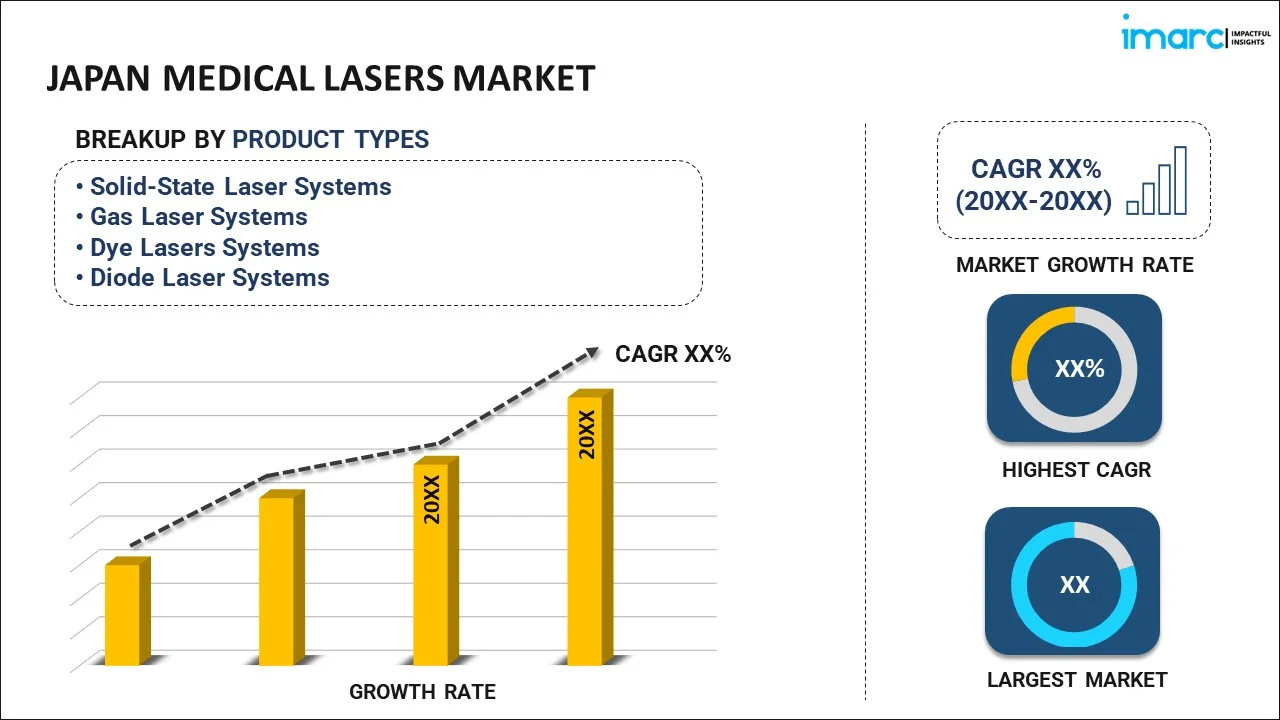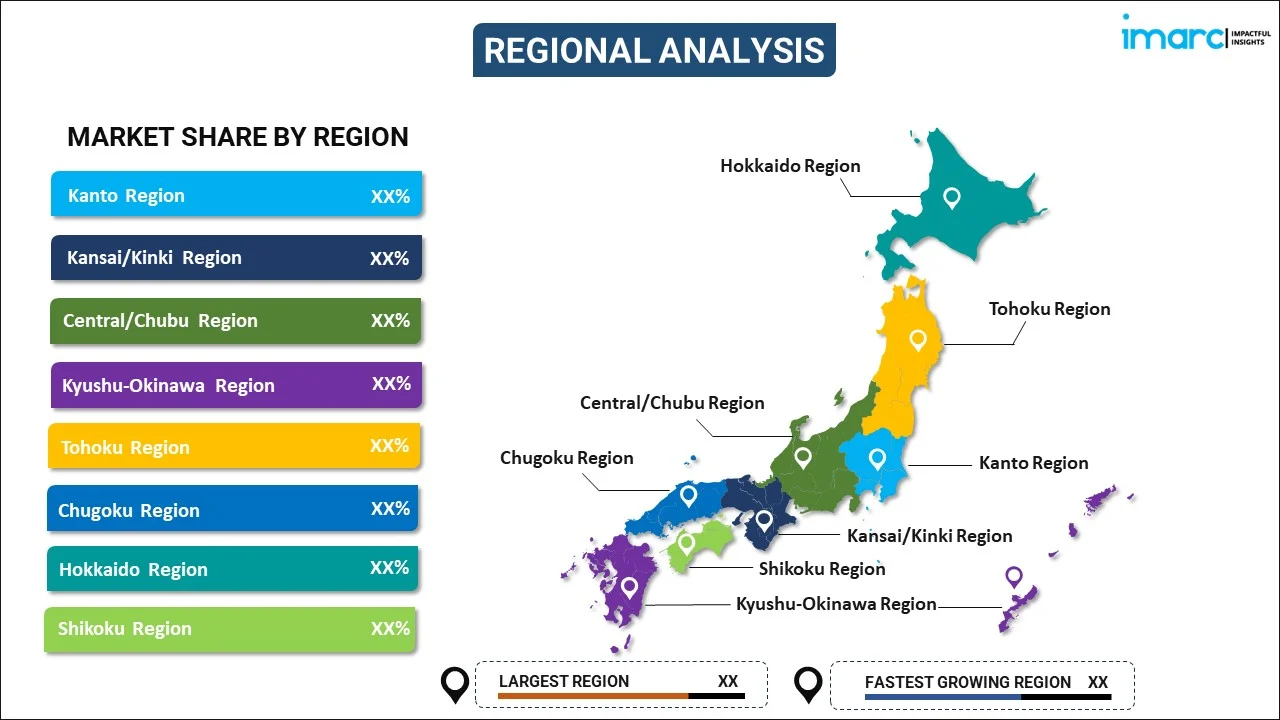
Japan Medical Lasers Market Report by Product Type (Solid-State Laser Systems, Gas Laser Systems, Dye Lasers Systems, Diode Laser Systems), Application (Ophthalmology, Dermatology, Gynecology, Dentistry, Urology, Cardiovascular, and Others), End User (Hospitals, Specialty Clinics, Ambulatory Surgical Centers), and Region 2025-2033
Market Overview:
Japan medical lasers market size reached USD 322.5 Million in 2024. Looking forward, IMARC Group expects the market to reach USD 901.5 Million by 2033, exhibiting a growth rate (CAGR) of 11.2% during 2025-2033. The emerging trend of medical tourism, coupled with the widespread adoption of aesthetic procedures, is primarily driving the market growth.
|
Report Attribute
|
Key Statistics
|
|---|---|
|
Base Year
|
2024
|
|
Forecast Years
|
2025-2033
|
|
Historical Years
|
2019-2024
|
| Market Size in 2024 | USD 322.5 Million |
| Market Forecast in 2033 | USD 901.5 Million |
| Market Growth Rate 2025-2033 | 11.2% |
Medical lasers are intricate devices employed for the treatment or removal of tissues through the precise concentration of light sources. They harness non-ionizing radiation to achieve outcomes such as reducing blood loss, alleviating postoperative discomfort, and lowering the risk of wound infections. These lasers play a pivotal role in an array of medical applications, including cancer therapy, bio-sensing, bio-imaging, drug delivery, and the diagnosis of cancer cells. Their utility extends to cosmetic surgery procedures, where they are used to eliminate tattoos, scars, stretch marks, sunspots, wrinkles, birthmarks, as well as to address spider veins and hair-related issues. Furthermore, medical lasers are indispensable in various medical procedures such as tumor and cataract removal, breast surgery, plastic surgery, and other surgical interventions. This widespread applicability positions them as integral tools in medical settings, spanning hospitals, specialized clinics, and ambulatory surgical centers.
Japan Medical Lasers Market Trends:
In the context of the Japanese market, the demand for medical lasers is on the rise due to the increasing adoption of minimally and non-invasive medical procedures aimed at enhancing clinical outcomes. This trend aligns with a growing awareness among individuals regarding aesthetic procedures, including the prevention of acne, body contouring, and dermal resurfacing, which stands as a prominent driver for market growth. Furthermore, the market's expansion is further catalyzed by technological advancements in laser-assisted devices, which support advanced healthcare treatments with a reduced risk of post-procedural complications. Initiatives by healthcare organizations to promote medical tourism present lucrative growth opportunities for industry stakeholders. Notably, key market players are heavily investing in research and development (R&D) endeavors, focusing on the introduction of low-level green lasers designed for body fat reduction. Moreover, the burgeoning healthcare industry, coupled with the increasing prevalence of eye disorders and a growing geriatric population, is exerting a positive influence on market growth. Rising disposable incomes among individuals in Japan are expected to propel the regional market over the forecasted period.
Japan Medical Lasers Market Segmentation:
IMARC Group provides an analysis of the key trends in each segment of the market, along with forecasts at the country level for 2025-2033. Our report has categorized the market based on product type, application, and end user.
Product Type Insights:

- Solid-State Laser Systems
- Holmium Yttrium Aluminum Garnet Laser (Ho:Yag) Systems
- Erbium Yttrium Aluminum Garnet Laser (Er:Yag) Systems
- Neodymium Yttrium Aluminum Garnet Laser (Nd:Yag) Systems
- Potassium Titanyl Phosphate Laser Systems
- Alexandrite Laser Systems
- Ruby Laser Systems
- Gas Laser Systems
- CO2 Laser Systems
- Argon Laser Systems
- Krypton Laser Systems
- Metal Vapor (Copper and Gold) Laser Systems
- Helium-Neon (He-Ne) Laser Systems
- Excimer Laser Systems
- Dye Lasers Systems
- Diode Laser Systems
The report has provided a detailed breakup and analysis of the market based on the product type. This includes solid-state laser systems (holmium yttrium aluminum garnet laser (Ho:Yag) systems, erbium yttrium aluminum garnet laser (Er:Yag) systems, neodymium yttrium aluminum garnet laser (Nd:Yag) systems, potassium titanyl phosphate laser systems, alexandrite laser systems, and ruby laser systems), gas laser systems (CO2 laser systems, argon laser systems, krypton laser systems, metal vapor (copper and gold) laser systems, helium-neon (He-Ne) laser systems, and excimer laser systems), dye lasers systems, and diode laser systems.
Application Insights:
- Ophthalmology
- Dermatology
- Gynecology
- Dentistry
- Urology
- Cardiovascular
- Others
A detailed breakup and analysis of the market based on the application have also been provided in the report. This includes ophthalmology, dermatology, gynecology, dentistry, urology, cardiovascular, and others.
End User Insights:
- Hospitals
- Specialty Clinics
- Ambulatory Surgical Centers
The report has provided a detailed breakup and analysis of the market based on the end user. This includes hospitals, specialty clinics, and ambulatory surgical centers.
Regional Insights:

- Kanto Region
- Kansai/Kinki Region
- Central/ Chubu Region
- Kyushu-Okinawa Region
- Tohoku Region
- Chugoku Region
- Hokkaido Region
- Shikoku Region
The report has also provided a comprehensive analysis of all the major regional markets, which include Kanto Region, Kansai/Kinki Region, Central/ Chubu Region, Kyushu-Okinawa Region, Tohoku Region, Chugoku Region, Hokkaido Region, and Shikoku Region.
Competitive Landscape:
The market research report has also provided a comprehensive analysis of the competitive landscape. Competitive analysis such as market structure, key player positioning, top winning strategies, competitive dashboard, and company evaluation quadrant has been covered in the report. Also, detailed profiles of all major companies have been provided.
Japan Medical Lasers Market Report Coverage:
| Report Features | Details |
|---|---|
| Base Year of the Analysis | 2024 |
| Historical Period | 2019-2024 |
| Forecast Period | 2025-2033 |
| Units | Million USD |
| Scope of the Report | Exploration of Historical Trends and Market Outlook, Industry Catalysts and Challenges, Segment-Wise Historical and Future Market Assessment:
|
| Product Types Covered |
|
| Applications Covered | Ophthalmology, Dermatology, Gynecology, Dentistry, Urology, Cardiovascular, Others |
| End Users Covered | Hospitals, Specialty Clinics, Ambulatory Surgical Centers |
| Regions Covered | Kanto Region, Kansai/Kinki Region, Central/ Chubu Region, Kyushu-Okinawa Region, Tohoku Region, Chugoku Region, Hokkaido Region, Shikoku Region |
| Customization Scope | 10% Free Customization |
| Post-Sale Analyst Support | 10-12 Weeks |
| Delivery Format | PDF and Excel through Email (We can also provide the editable version of the report in PPT/Word format on special request) |
Key Questions Answered in This Report:
- How has the Japan medical lasers market performed so far and how will it perform in the coming years?
- What has been the impact of COVID-19 on the Japan medical lasers market?
- What is the breakup of the Japan medical lasers market on the basis of product type?
- What is the breakup of the Japan medical lasers market on the basis of application?
- What is the breakup of the Japan medical lasers market on the basis of end user?
- What are the various stages in the value chain of the Japan medical lasers market?
- What are the key driving factors and challenges in the Japan medical lasers?
- What is the structure of the Japan medical lasers market and who are the key players?
- What is the degree of competition in the Japan medical lasers market?
Key Benefits for Stakeholders:
- IMARC’s industry report offers a comprehensive quantitative analysis of various market segments, historical and current market trends, market forecasts, and dynamics of the Japan medical lasers market from 2019-2033.
- The research report provides the latest information on the market drivers, challenges, and opportunities in the Japan medical lasers market.
- Porter's five forces analysis assist stakeholders in assessing the impact of new entrants, competitive rivalry, supplier power, buyer power, and the threat of substitution. It helps stakeholders to analyze the level of competition within the Japan medical lasers industry and its attractiveness.
- Competitive landscape allows stakeholders to understand their competitive environment and provides an insight into the current positions of key players in the market.
Need more help?
- Speak to our experienced analysts for insights on the current market scenarios.
- Include additional segments and countries to customize the report as per your requirement.
- Gain an unparalleled competitive advantage in your domain by understanding how to utilize the report and positively impacting your operations and revenue.
- For further assistance, please connect with our analysts.
 Inquire Before Buying
Inquire Before Buying
 Speak to an Analyst
Speak to an Analyst
 Request Brochure
Request Brochure
 Request Customization
Request Customization




.webp)




.webp)












